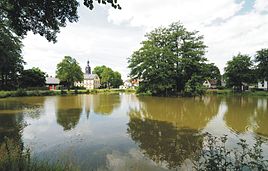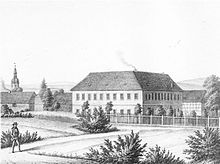Posseck (Vogtland)
|
Posseck
Triebel / Vogtl municipality .
Coordinates: 50 ° 20 ′ 1 ″ N , 12 ° 4 ′ 29 ″ E
|
||
|---|---|---|
| Height : | 560 m | |
| Residents : | 244 (Jan. 1, 2012) | |
| Incorporation : | January 1, 1993 | |
| Postal code : | 08606 | |
| Area code : | 037434 | |
|
Location of Posseck in Saxony |
||
|
View over the village pond to the church
|
||
Posseck is a part of the municipality of Triebel / Vogtl. in the Saxon Vogtland district .
geography
The place is located in the southwest of Saxony in the Vogtland not far from the border with Bavaria and the Czech Republic . The village is located near the watershed of the Saale and Weißer Elster in the open, flat valley basin of the Seifbach, which drains south to the Saale in Bavaria. The panoramic 615 m high Galgenberg near Gassenreuth and the wooded 635 m high Platzerberg are both located on the boundary of Posseck.
The hamlets Höllensteg and Grünpöhl belong to Posseck. Until 1993, Gassenreuth and Haselrain were districts of the community Posseck, after the incorporation they were continued as Triebel districts.
history
Founded until the 17th century
The name Posseck is derived from the Old Sorbian word possěk , which means logging. The place was first mentioned in 1325 as "(the building) ze Possek". It can be assumed, however, that slavic settlers built lassgüter there well before that, from the Vorwerk in Nentschau . In any case, in 1324 the progenitor of the von Reitzenstein family , Konrad von der Grun, acquired the area around Posseck with several villages and hamlets. At that time the area still belonged to the Regnitzland . With the approval of the bailiff of Weida , probably from Heinrich XI., "The elder" , Konrad von Reitzenstein was allowed to build the "building" or the "hofe" in Posseck in 1325. Where this castle was located is unclear today, as it was destroyed again in the Vogtland War in 1355. Thereupon, also in 1355, the Bohemian King Emperor Charles IV forbade that the castles in Posseck and in Gattendorf , which were alleged robbery houses, would be rebuilt.
For the right to build a church and a burial place in Posseck, Konrad von Reitzenstein signed an exchange contract with the pastor of Regnitzlosau in 1340 and gave the little village of Haag near Regnitzlosau in return. The church in Posseck was thus a branch church of Regnitzlosau, whose mother church was St. Lorenz zu Hof (Saale) . Since the right of patronage was also transferred to von Reitzenstein with the barter agreement, the Posseck church was later not affected by the dispute parish problem to the same extent as the other neighboring churches on the Saxon side. Nevertheless Posseck was closely connected with the Bavarian Nentschau. The block and forest hooves are interlocked with the one in Nentschau. In addition to Nentschau, the hamlets of Zech and Mittelhammer in Bavaria also belonged to the Parochie Posseck.
After the Hussite Wars in the 15th century had already caused horror in the town, the Thirty Years' War demonstrably caused severe devastation 200 years later. In 1632, according to the parish register, many parish priests were "pathetically shot and massacred" and the church robbed of all its vestments . In 1633 General Holk, who went down in history as the “flayer of the Vogtland”, died in the neighboring town of Troschenreuth . And finally, on April 13, 1641, Bavarian troops set fire to half the village with the school and parish during a rendezvous above the town. At the same time, due to the plague and leafing (leafing epidemic 1654), a new churchyard was created outside and (because of the main wind direction) east of the village.
17th century to the present
The manor remained in the possession of the von Reitzenstein family over the centuries. In 1695 they also built today's baroque palace. It was not until 1782 that the Reitzenstein family sold the manor to Christoph Ernst von Feilitzsch , lord of Trogen . In 1850 it came into bourgeois hands. In 1901 it was bought by the Hof spinning mill owner Julius Schmidt. He had the palace and park renovated, so that it was soon considered one of the most beautiful estates in the area. His widow was expropriated in 1945. The manor included a brickworks and a sheep farm. In addition to farmers, there were also weavers, tailors, shoemakers and carpenters in the village, as well as a blacksmith, a baker, a cooper and a potter. Posseck belonged to the Voigtsberg office until the 19th century .
The division of Germany after the Second World War and the drawing of the inner German border were particularly bitter for Posseck. The border fortifications were drawn immediately south of the town, even across the castle garden, and messed up the townscape massively. Centuries-old connections to Bavaria were cut. The place was in the restricted border area and could only be reached by residents with a permit. The barracks of the Posseck border company were set up hidden in the forest near the Höllensteg district, which monitored the border and the village. The church and cemetery were neglected. After the fall of the Wall in 1989, the road to Nentschau was reopened on December 22nd. Most of the border installations have now been dismantled. In 1993 Posseck was in Triebel / Vogtl. incorporated.
Worth seeing
- The church dates from 1784. The interior of the hall church building was built in 1832. The building was renovated in 1929. During the GDR era, the church almost became a ruin. In 1972 it was closed due to the risk of collapse and the organ was sold. Just a few days after the opening of the border, on December 27, 1989, craftsmen from Regnitzlosau carried out an emergency repair on the roof. In the meantime, the outside of the church is fine. A renovation inside is still pending. There is a pulpit altar , a baroque baptismal angel and in the middle of the nave under two marble slabs in the floor the hereditary burial of the von Reitzenstein family.
- The baroque building of the former manor (Posseck Castle), threatened by decay, dates from the 14th century in its core and has hardly been changed externally since the 18th century. The three-winged and horseshoe-shaped structure has an inner courtyard that opens onto the market square (today the village square). The hipped roof is slated. The three sandstone portals have - rare in Saxony - ornamental decorations of Mannerism / Early Baroque. A coat of arms with the year 1695 can be seen above the basket arch portal in the courtyard. After the expropriation in 1945, the building was used as a cultural center during the GDR era. With the incorporation of Posseck to Triebel in 1993, the community ceased to use it. In 1998 the Triebel municipality sold it to a Dortmund entrepreneur after a tender. Since the building could no longer be saved, they transferred the property to the current owner, Schloßpark Posseck e. V.
- The largest stone cross in the Vogtland is in front of the church. It is 165 cm high, 105 cm wide and 26 cm deep. It is not made of granite, as is usual in the Vogtland, but is carved from sandstone.
Hell's bridge
The hamlet probably got its German name from a field name . Hell was once a particularly remote and inaccessible place in the forest. The raw materials for the brickworks in Posseck were extracted in Höllensteg. After the fall of the Berlin Wall in the 1990s, the buildings of the Posseck border company briefly served as a home for asylum seekers and are now privately owned. Because they are still in their original state of preservation, they are offered as film sets.
literature
- New Saxon Church Gallery (1913) - at the Saxon State Library - Dresden State and University Library (SLUB)
- Album of the manors and castles in the Kingdom of Saxony (1859) - at the Saxon State Library - State and University Library Dresden (SLUB)
- Wolfgang Seffner: The manors of the Vogtland, their fate in the 20th century , Plauen 2002
- Matthias Donath: Castles and mansions in Vogtland , Meißen 2011
Web links
- Description of the places in the community of Triebel / Vogtl.
- Parish Posseck
- Picture gallery inner-German border triangle Pooeck
- Posseck Castle in the Saxony Castle Catalog
- Picture album by Posseck immediately after the opening of the border in 1990
Individual evidence
- ↑ http://www.gemeinde-triebel.de/
- ^ Jörg Fischer, Plauen: From Posseck to Blankenberg - weir systems in the former border area with Bavaria ; in: Communications from the Association for Vogtland History, Folklore and Regional Studies , 18th annual, Plauen 2012
- ^ Posseck in the Digital Historical Directory of Saxony
- ↑ a b Georg Dehio et al .: Handbuch der Deutschen Kunstdenkmäler. Saxony II. Administrative districts Leipzig and Chemnitz . Munich, Berlin 1998. pp. 989-990
- ↑ http://www.mdm-online.de/index.php?id=locationguide Mitteldeutsche Medienförderung - Location-Guide, sub-category: Military and border installations



